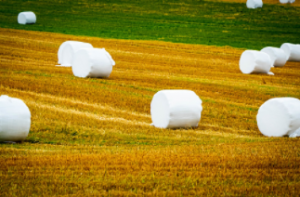Hay Baling is an old technique still being used today. However, there are new advances in hay baling technology and more uses for silage wrap. Silage wraps or bales are thick plastic sheeting usually manufactured from woven polyethylene or polypropylene fibres. Hay bales are primarily made to store hay and other farm implements, food storage, animal feed, pet supplies and chemicals. These products are made from by-products or scraps of the crop used to manufacture the finished product.
 Hay bales are essential because they help conserve moisture. Hay is low in moisture because it has already been plucked before being dried. The silage wrap also helps conserve moisture because hay has already been bled before being made into a wrap. Therefore, the airflow through the bale is more even, and there is no chance of moisture from hay smoke getting trapped in the fabric of the silage wrap.
Hay bales are essential because they help conserve moisture. Hay is low in moisture because it has already been plucked before being dried. The silage wrap also helps conserve moisture because hay has already been bled before being made into a wrap. Therefore, the airflow through the bale is more even, and there is no chance of moisture from hay smoke getting trapped in the fabric of the silage wrap.
The silage_wrap layers are aerated or expelled. This process is done so the layers of the plastic sheet remain intact and prevent any cracking of the plastic. When silage is fired in a kiln, the moisture content is reduced. The silage wrapping layer also moves faster than the air, creating faster cooling. The speed of the cooling means the wrapping layers stay fresh longer.
The silage wrap can also be used for hay because the air circulation and cooling speeds help prevent fermentation. Hay can be used for up to 3 years if stored adequately with good quality hay. Forage harvested early also contains nutrients that improve the flavour of the forage, which helps prolong the life of the bales. The longer the bales are exposed to the air and sunlight, the longer they can ferment and release their sugars.
Traditional silage preparation is done by burning the bales over a fire. With the silage wrap, the heat from the fire is directed on the plastic waste instead of the bales. It ensures a natural burning environment without the addition of chemicals to the earth’s surface. By burning the plastic waste in this way, the temperature of the groundwater is raised. It raises the soil’s acidity, which kills the roots of the grass that feed the bales.
The silage wrap can be purchased online and from local sources. The materials required are not expensive, and there is a wide range of designs for every need. Many companies sell customized wrapping paper based on the customer’s specifications. Customized wrapping paper comes in various colours and with various prints, including animals, floral, and landscape designs.
The advantage of using silage_wrap instead of burring the plastic wrap or making do-it-yourself designs is that the finished product is more resistant to the elements. The plastic wrap can easily succumb to rot and mould, both of which are damaging to the product. In contrast, the wrap is more resistant to the elements. Even if a bit of rain did fall on the bales, it would not cause any damage. The wrapped bales will dry out and revert to their original state.
Another advantage of the silage wrap is that it prevents a layer of dry matter from forming above the bales. The moisture from the sun is trapped within the folds of the wrap when it is being wrapped. As the wrap dries, the moisture drains out of the wrapping and lands on the fresh, new layer of soil below. It leaves the soil with pockets and depressions which hold moisture. If the humidity in the surrounding air is less than 40 per cent, the pockets and depressions will not form, and the silage wrap will continue to work.